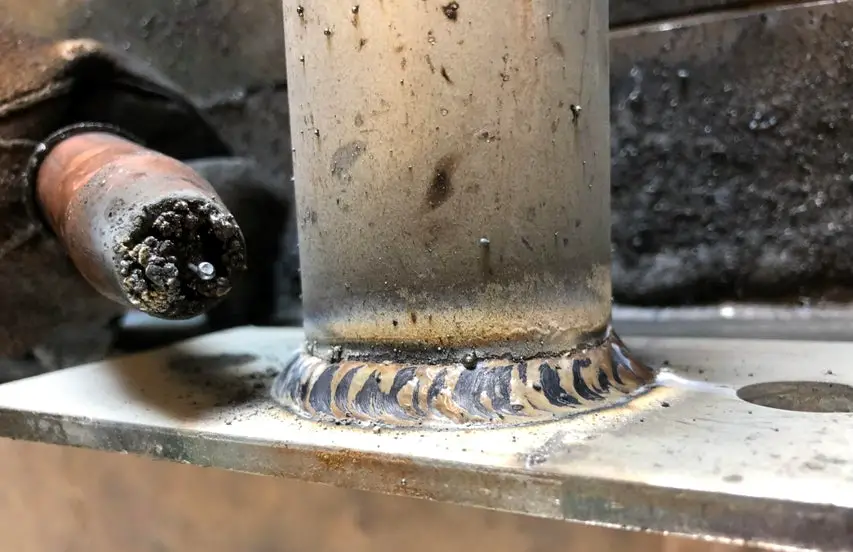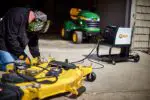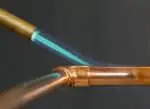Sputtering in MIG welding is inevitable. The process is where metals are made to melt and joined with each other with the aid of a torch that creates an intense hot arc. What more can you accept than the metals scattering around in hot droplets when you do this?
But, this does not mean that half of the filler metal shall go scatter everywhere. Are you facing this problem? Do you find that your MIG welding is not smooth due to the sputtering?
Don’t worry, for this blog is listing out the reasons that could potentially be causing this. Once you find your fault, all you have to do is rectify it and you are good to go. So do not waste time, dive in and explore!
1. Irregular current flow can be quite messy!
Current determines almost everything in MIG welding. It creates an environment that is hot enough for the metals to melt. It ignites the machine and determines the quality of the weld.
The current flow should be optimal for the proper drawing of the arc. If the current flow is lower than the required level, the welding rod might stick to the piece you are welding as the scales will be thick. The bead profile would not be perfect.
If the current flow is high the smoke created will be more along with spattering. The high temperature will make the weld pool too hot and the rod red. Undercut will be the result.
2. Feeding speed could be the reason.
Filler metal feeding speed determines the spatter level to a great extent. Feeding a metal to the weld pool needs to be done at a pace that does not affect the flow of the procedure.
If the feeding is too slow then the filler metal will melt before it reaches the weld pool. This results in the metal getting sprayed in the air as it is now in the liquid form, thereby, creating spatter.
This could also clog the tip of the gun making the situation even worse. Spattering will be very high in such a situation.
If the feeding is too fast the filler metal will hit the weld pool before it melts creating a disruption. The metal will not combine and obstruct the flow of the process. This can lead to high spattering.
Feeding should be done without any inconsistencies smoothly to see the same reflected in the weld.
3. Contaminations can get in the way
Metals that you use for welding might not be dirt free. Any presence of another material on the surface of the metal can impact the movement of the arc. Dirt can act as a nuisance that stands in the way of good spatter-less welding.
And this is applicable not just with the base metal but also with the filler metal. So it is wise to choose metals that are free of contamination or dirt.
Look out for grease, oil, or any other external coatings that are there on metal surfaces. Clean them before you weld.
4. Angle of the welding gun can be a problem
The angle of the MIG welding gun determines the amount of spatter. Moving beyond a 15-degree angle will result in spattering. A steep position is prone to high spattering as well.
Therefore try to learn the right way to hold the welding gun for this could be the reason that you are facing the problem while everything else is perfect.
5. Your machine might be at fault
Yes, this could also create more spatter than usual. If the machines are not working properly or if the setup is not solid enough, then the problem of spattering can arise.
For instance, if the ground clamp is not properly put, the connection will be affected, resulting in disruptions in the flow. Also, an unclean ground clamp will not be able to establish contact between the cable and the machine.
Similarly, see that the regulators and ports are connected well so that the shielding gas flows correctly.
Likewise, make sure that all the components are fitted as they ought to be. Any fault in the setup can affect the smoothness of the process.
6. Low-quality metals are not good news
Be it the filler or base metal, quality matters. Easiness of work is lower for low-quality metals. Cheaper metals are made with filler metals hence the price.
This renders these metals not suitable for welding and when tried to work upon can create spatter way more than high-quality metals.
7. Shielding gas might be creating the issue
For MIG welding shielding gases are important. It keeps the metals from reacting with the atmosphere. Spattering might be the issue because of the wrong selection of shielding gas for the type of metal and kind of welding you are doing.
For MIG welding the most common shielding gases used are Argon and Carbon dioxide. The wrong combination of gas and metal can easily lead to a whole lot of spattering.
Quick tips to keep spattering nuisance at bay
1. Learn well!
Welding is an art if you want it to be. Learn the techniques well. If you are not thorough with how the procedure is to be carried out you will end up doing something that you are not comfortable with.
So make sure to observe other welders, watch good videos, and most important of all practice. Spattering can be controlled if you are doing everything as it should be done.
2. Anti-spatter spray can do the trick!
- A convenient solvent based, quick-drying aerosol that allows for pre-heat, higher duty cycles and higher temperature applications
- Excellent for fixture and tooling protection
- Paintable, non-flammable, no fluorocarbons
- Regular use reduces the need for grinding and other clean-up tasks
- 20 oz Aerosol can
Prices pulled from the Amazon Product Advertising API on:
Product prices and availability are accurate as of the date/time indicated and are subject to change. Any price and availability information displayed on [relevant Amazon Site(s), as applicable] at the time of purchase will apply to the purchase of this product.
Anti-spatter spray is an oil-based chemical composition. When sprayed on the metal or the surrounding that you are welding, the spatter balls tend to come out from these surfaces easily. They will stay loose and can easily be chipped off.
3. Keep mill scales out of the way!
Mill scales are the iron oxides that develop on the surface of steel when it is rolled. Their presence can create spattering during MIG welding. So make sure to get rid of mill scales of steel before you start welding. You can grind them or chip them off.
4. Try pulsed MIG welding.
Pulsed MIG welding is a newer method of MIG welding. The machines with this setup can give you better arc control and lower heat input. This results in spatter-less welding where penetration will be smoother and bead profile perfect.
5. A chisel or hammer will be handy
A spatter hammer or chisel will make it easy to get rid of the stubborn spatter balls stuck to the metal or other surfaces. With a slight push, you will manage to clear the solid drops easily.
6. A grinder can also come to the rescue!
Grinders would not chip away the spatter balls, rather, grind them till they vanish.
A grinder machine does not need you to move your hand like a chisel or hammer to clear the area. Once started it will work on its own. Just keep it on the surface and the rest will be taken care of.
Conclusion
Spattering is a part of welding. It will be there no matter how hard you try. But, when it stands in the way and becomes too much, you will have to examine the reason behind it and solve it.
The purpose of the blog was exactly that- to make you understand the common flaws that lead to over-spattering while MIG welding. Hope it worked out!
Thank you for reading! Come back for more!








